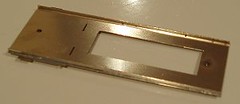In an effort to introduce some science into this, I’ve compared the lead free solder against some convential stuff.
The footplate for the Barclay is laminated from two parts. One has parts to fold down to make the valances. The other is the top surface with checker plate on it. What I do is place the top face down on the board and put the other part on top. Solder is run down the side by the valance with plenty of flux. This is enough to attach the parts and hopefully hide the join.
On one side I used lead free from Maplin. On the other leaded cored solder from Screwfix (I use normal cored solder for all my etched brass work). The same flux from a DIY store was used.
Result. Both as good as each other. I also fitted the retaining nuts, again one with each type of solder. Same result, both work fine. I did have to use PowerFlow flux as the nuts were steel but you couldn’t tell the difference.

1 comment:
Hi there.
What do you use for flux, and where do you get it? (I live in Leamington too so a local supplier would be good).
I need to solder a few bits of brass together for the chassis of the new engine I'm working on, but I've not really soldered brass before. I had a bit of a play (without any kind of flux other than whatever is in the solder) and wasn't very happy with the results.
Any top tips for a complete beginner?
Tom
Post a Comment